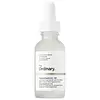What's inside
What's inside
 Key Ingredients
Key Ingredients

 Benefits
Benefits

 Concerns
Concerns

No concerns
 Ingredients Side-by-side
Ingredients Side-by-side

Water
Skin ConditioningAlpha-Arbutin
AntioxidantPhenethyl Alcohol
MaskingHydroxyethylcellulose
Emulsion StabilisingPropylene Glycol
HumectantAloe Barbadensis Leaf Juice Powder
Skin ConditioningTriethanolamine
Buffering1,2-Hexanediol
Skin ConditioningCitric Acid
BufferingGlycerin
HumectantSodium Acetate
BufferingCitrus Grandis Peel Water
HumectantSodium PCA
HumectantIsopropyl Alcohol
SolventPentylene Glycol
Skin ConditioningCellulose
AbsorbentErythritol
HumectantCarrageenan
Sodium Acetylated Hyaluronate
HumectantSodium Hyaluronate
HumectantXanthan Gum
EmulsifyingSodium Hyaluronate Crosspolymer
HumectantEthylhexylglycerin
Skin ConditioningHydrolyzed Sodium Hyaluronate
Skin ConditioningPhenoxyethanol
PreservativeWater, Alpha-Arbutin, Phenethyl Alcohol, Hydroxyethylcellulose, Propylene Glycol, Aloe Barbadensis Leaf Juice Powder, Triethanolamine, 1,2-Hexanediol, Citric Acid, Glycerin, Sodium Acetate, Citrus Grandis Peel Water, Sodium PCA, Isopropyl Alcohol, Pentylene Glycol, Cellulose, Erythritol, Carrageenan, Sodium Acetylated Hyaluronate, Sodium Hyaluronate, Xanthan Gum, Sodium Hyaluronate Crosspolymer, Ethylhexylglycerin, Hydrolyzed Sodium Hyaluronate, Phenoxyethanol
 Reviews
Reviews

Ingredients Explained
These ingredients are found in both products.
Ingredients higher up in an ingredient list are typically present in a larger amount.
Alpha-Arbutin is made from hydroquinone and glucose. It may also be derived from the fermentation of soybeans.
This ingredient an antioxidant, meaning it helps protect your skin cells against damage.
Studies show this ingredient helps improve hyperpigmentation and fade discoloration.
Alpha-Arbutin may be used with other ingredients that help with hyperpigmentation. These ingredients include retinol, Vitamin C, niacinamide, and tranexamic acid.
Learn more about Alpha-ArbutinThis ingredient is created by putting sodium hyaluronate through hydrolysis.
You might know this as 'mini' or 'ultra low-molecular weight' hyaluronic acid. The small molecule size means it is able to travel deeper in the skin.
According to studies, low molecular-weight hyaluronic acid can:
One study from 2011 found ultra-low weight HA to show pro-inflammatory properties. Another study from 2022 found it to downregulate UV-B induced inflammation.
Hydrolysis is a process of changing a molecule using water or enzymes.
This ingredient is water-soluble.
Learn more about Hydrolyzed Sodium HyaluronatePhenoxyethanol is a preservative that has germicide, antimicrobial, and aromatic properties. Studies show that phenoxyethanol can prevent microbial growth. By itself, it has a scent that is similar to that of a rose.
It's often used in formulations along with Caprylyl Glycol to preserve the shelf life of products.
Water. It's the most common cosmetic ingredient of all. You'll usually see it at the top of ingredient lists, meaning that it makes up the largest part of the product.
So why is it so popular? Water most often acts as a solvent - this means that it helps dissolve other ingredients into the formulation.
You'll also recognize water as that liquid we all need to stay alive. If you see this, drink a glass of water. Stay hydrated!
Learn more about Water